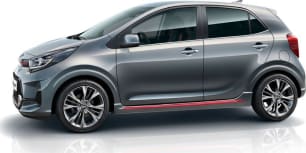“We cannot think of a better new car buy for under $20K” is what we thought late in 2021 after spending a week with the Picanto GT.
Then the inevitable happened, with a hike of $500 taking that to $20,490 before on-road costs (ORC) – or, $22,490 driveaway as promoted on Kia’s website. Costing just $17,990 back at its early 2019 launch, note that prices have since jumped nearly 15 per cent.
So, what does the GT offer that the base $15,990 MY22 Picanto S doesn’t?
Well, for starters, your $4500 premium scores a smaller engine with fewer cylinders – a 1.0-litre three-cylinder instead of a 1.2-litre four-cylinder unit. Yet with the aid of a turbo, it pumps out 12kW and 50Nm more power and torque respectively, so it’s pokier.
The GT also boasts sports suspension that's tuned locally, a body kit, two-inch larger alloys sheathed in 195/45R16 tyres, halogen projection headlights with LED daytime running lights, fog lights, sports seats offering stripy pleather hide, a front centre armrest, height-adjustable front seat belts, electric-folding/heated exterior mirrors, ‘premium’ steering wheel, alloy pedals, extra storage and fancier trim inside and out.
On the safety front, even the entry-level Picanto S features four-wheel disc brakes, Autonomous Emergency Braking (AEB) with Forward Collision Warning, anti-lock brakes with Electronic Brake-force Distribution and Brake Assist, electronic stability control, traction control, Vehicle Stability Management, hill-start assist, dual front airbags, front-side airbags, curtain airbags, alarm and child restraint anchorage points (with a trio of top tether and a pair of ISOFIX positions).
You’ll also find reverse parking sensors, a rear camera, auto on/off headlights, remote central locking, power windows, air conditioning, cruise control with speed limiter, a single USB port, an eight-inch touchscreen, wireless Apple CarPlay/Android Auto, Bluetooth connectivity, four audio speakers, steering-wheel mounted controls and a temporary spare wheel. Oh, and let’s not forget Kia's seven-year warranty.
That’s a fair whack of kit for the cash. In fact, the Picanto offers pretty much everything you expect and then some. In contrast, the Mitsubishi Mirage feels cheap while the MG3 and Fiat 500 are old and lack some driver-assist safety as well as some of the features standard in the GT.
Little wonder, then, that the Picanto is such a big player in its class.
However, the GT is now butting up against a pair of bigger, roomier and more sophisticated rivals – the Suzuki Swift GL Navigator also from $20,490 as well as the Mazda2 G15 Pure from $21,190. At least it looks sporty inside and out. For that, you’ll need the step up to the costlier Swift GLX Turbo and Mazda2 Pure SP.
Note though that the Kia is showing its age in one key area – the unavailability of driver-assist tech like adaptive cruise control, blind spot monitoring, Rear Cross Traffic Alert and lane-keep alert/assist systems.

